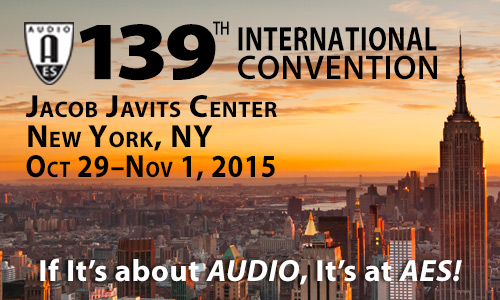
AES New York 2015
Poster Session P3
Thursday, October 29, 11:00 am — 12:30 pm (S-Foyer 1)
Poster: P3 - Transducers/Perception
P3-1 Predicting the Acoustic Power Radiation from Loudspeaker Cabinets: A Numerically Efficient Approach—Mattia Cobianchi, B&W Group Ltd. - West Sussex, UK; Martial Rousseau, B&W Group Ltd. - West Sussex, UK
Loudspeaker cabinets should not contribute at all to the total sound radiation but aim instead to be a perfectly rigid box that encloses the drive units. To achieve this goal, state of the art FEM software packages and Doppler vibro-meters are the tools at our disposal. The modeling steps covered in the paper are: measuring and fitting orthotropic material properties, including damping; 3D mechanical modeling with a curvilinear coordinates system and thin elastic layers to represent glue joints; scanning laser Doppler measurements and single point vibration measurements with an accelerometer. Additionally a numerically efficient post-processing approach used to extract the total radiated acoustic power and an example of what kind of improvement can be expected from a typical design optimization are presented.
Convention Paper 9367 (Purchase now)
P3-2 New Method to Detect Rub and Buzz of Loudspeakers Based on Psychoacoustic Sharpness—Tingting Zhou, Nanjing Normal University - Nanjing, Jiangsu, China; Ming Zhang, Nanjing Normal University - Nanjing, Jiangsu, China; Chen Li, Nanjing Normal University - Nanjing, Jiangsu, China
The distortion detection of loudspeakers has been researched for a very long time. Researchers are committed to finding an objective way to detect Rub and Buzz (R&B) in loudspeakers that is in line with human ear feelings. This paper applies the psychoacoustics to distortion detection of loudspeakers and describes a new method to detect the R&B based on the psychoacoustic sharpness. Experiments show, comparing with existing objective detection methods of R&B, detection results based on the proposed method are more consistent with subjective judgments.
Convention Paper 9368 (Purchase now)
P3-3 Modal Impedances and the Boundary Element Method: An Application to Horns and Ducts—Bjørn Kolbrek, Norwegian University of Science and Technology - Trondheim, Norway
Loudspeaker horns, waveguides, and other ducts can be simulated by general numerical methods, like the Finite Element or Boundary Element Methods (FEM or BEM), or by a method using a modal description of the sound field, called the Mode Matching Method (MMM). BEM and FEM can describe a general geometry but are often computationally expensive. MMM, on the other hand, is fast, easily scalable, requires no mesh generation and little memory but can only be applied to a limited set of geometries. This paper shows how BEM and MMM can be combined in order to efficiently simulate horns where part of the horn must be described by a general meshed geometry. Both BEM-MMM and MMM-BEM couplings are described, and examples given.
Convention Paper 9369 (Purchase now)
P3-4 Audibility Threshold of Auditory-Adapted Exponential Transfer-Function Smoothing (AAS) Applied to Loudspeaker Impulse Responses—Florian Völk, Technische Universität München - München, Germany; WindAcoustics UG (haftungsbeschränkt) - Windach, Germany; Yuliya Fedchenko, Technische Universität München - Munich, Germany; Hugo Fastl, Technical University of Munich - Munich, Germany
A reverberant acoustical system’s transfer function may show deep notches or pronounced peaks, requiring large linear amplification in the play-back system when used, for example, in auralization or for convolution reverb. It is common practice to apply spectral smoothing, with the aim of reducing spectral fluctuation without degrading auditory-relevant information. A procedure referred to as auditory-adapted exponential smoothing (AAS) was proposed earlier, adapted to the spectral properties of the hearing system by implementing frequency-dependent smoothing bandwidths. This contribution presents listening experiments aimed at determining the audibility threshold of auditory-adapted exponential smoothing, which is the maximum amount of spectral smoothing allowed without being audible. As the results depend on the specific acoustic system, parametrization guidelines are proposed.
Convention Paper 9371 (Purchase now)
P3-5 Developing a Timbrometer: Perceptually-Motivated Audio Signal Metering—Duncan Williams, University of Plymouth - Devon, UK
Early experiments suggest that a universally agreed upon timbral lexicon is not possible, and nor would such a tool be intrinsically useful to musicians, composers, or audio engineers. Therefore the goal of this work is to develop perceptually-calibrated metering tools, with a similar interface and usability to that of existing loudness meters, by making use of a linear regression model to match large numbers of acoustic features to listener reported timbral descriptors. This paper presents work towards a proof-of-concept combination of acoustic measurement and human listening tests in order to explore connections between 135 acoustic features and 3 timbral descriptors, brightness, warmth, and roughness.
Convention Paper 9372 (Purchase now)
P3-6 A Method of Equal Loudness Compensation for Uncalibrated Listening Systems—Oliver Hawker, Birmingham City University - Birmingham, UK; Yonghao Wang, Birmingham City University - Birmingham, UK
Equal-loudness contours represent the sound-pressure-level-dependent frequency response of the auditory system, which implies an arbitrary change in the perceived spectral balance of a sound when the sound-pressure-level is modified. The present paper postulates an approximate proportional relationship between loudness and sound-pressure-level, permitting relative loudness modification of an audio signal while maintaining a constant spectral balance without an absolute sound-pressure-level reference. A prototype implementation is presented and accessible at [1]. Preliminary listening tests are performed to demonstrate the benefits of the described method.
Convention Paper 9373 (Purchase now)
